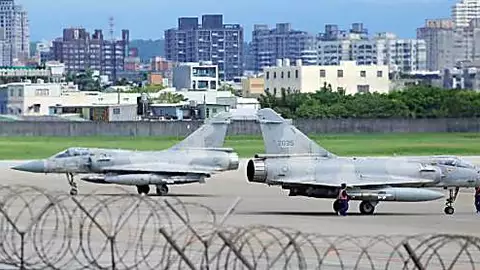Latest sanction effort likely to backfire and cause market turmoil

An oil platform at the Kravtsovskoye oilfield in the Baltic Sea, Russia, in September 2021: China and India helped prevent a major squeeze on global supplies and took some heat out of price pressures. © Reuters
Vandana Hari is founder of Vanda Insights, a Singapore-based global energy market intelligence provider.
In another misguided attempt to starve the Kremlin of funds to continue its war in Ukraine, Western allies are seeking to form a global buyers’ cartel that would impose a ceiling on the price Russia gets for its crude oil in overseas markets.
Major importers China and India, whose support the West needs for the plan to succeed, have so far been noncommittal. The two would do well to go further by unequivocally rejecting the idea and dooming it to the bin.
The successive rounds of sanctions by the U.S. and the EU against Russia are understandable, as are their increasingly desperate search for ways to curtail the oil sale revenues that are helping fund Russia’s onslaught in Ukraine. The NATO allies have pledged to defend Ukraine’s independence.
What is less comprehensible is their continuing to do the same things and expecting different results. More worrisome are the EU’s moves to progressively gamble away its energy security under the apparent illusion that its next hastily engineered move will cripple Moscow and set everything right.
Political judgments aside, the fact remains that China and India have not joined the coalition condemning Russia or taken steps to isolate and punish it. Beijing has continued to pledge full support for President Vladimir Putin since the Ukraine invasion, while New Delhi has steadfastly stayed neutral.
As the Asian giants weigh requests to join a proposed coalition of buyers to set a price cap on Russian oil, they are well aware that the unprecedented and unwieldy plan has an extremely low probability of delivering the results intended and indeed stands a high chance of sowing more chaos in the global oil market.
If China and India also take into account the failure of the West’s blitz of energy sanctions to deter Russia from continuing its military advance and the disastrous unintended consequences already felt in the EU, their response to the price cap proposal would be a resounding “no.”
The U.S., among the first major countries to place an immediate and complete ban on imports of Russian oil after the invasion, could afford to do so as a net oil exporter. As the EU began to wean itself off Russian crude and refined oil imports, the U.S. even benefited by capturing a bigger share of the European market for its own production.
The U.S. sanctions and the EU’s voluntary boycott tightened global supplies, driving crude prices to a 14-year high in March. U.S. pump prices climbed further to an all-time peak above $5 a gallon as the summer driving season got underway.
Last month, U.S. President Joe Biden was forced to make a conciliatory visit to Saudi Arabia, reversing promises to treat the country as a pariah over the 2018 killing of Washington Post journalist Jamal Khashoggi. Biden’s remorse, though, failed to coax Riyadh to pump more oil to help relieve upward price pressures.
With its first six rounds of sanctions against Moscow, the EU was careful to protect purchases of Russian gas. But Russia still retaliated by slashing supplies of the clean-burning fuel.
About a dozen countries in the bloc have completely lost access to Russian gas or seen their inflows curtailed. As a result, gas and electricity prices in Europe have remained elevated even as global oil prices have been cooling in recent weeks amid recessionary fears.
The EU has been forced to import liquefied natural gas at record prices, set aside its emission reduction targets and fall back on coal and oil for power generation and industrial use. The bloc’s 27 members have recently agreed to voluntarily curb gas consumption by 15% in a desperate bid to conserve supply for winter, though certain industries and countries have been granted exemptions.
The world is watching in disbelief as some of the richest countries on the planet are hurtling, almost helplessly, toward what could be their worst energy crisis since the 1970s oil price shock, as well as near-certain economic devastation.
The price cap proposal, championed by U.S. Treasury Secretary Janet Yellen and endorsed by Group of Seven national leaders in late June, would seem advantageous to all importers since, in theory, it would result in a significant lowering of the price of Russian crude below already discounted levels. But the complexity of international oil markets, and of the scheme itself, mean the odds are stacked against the idea working as planned.
Moreover, the West’s misadventures in tit-for-tat energy weaponization over Ukraine strip its leaders of all credibility in pushing yet another ploy to try and get the better of Moscow, with oil and gas consumers around the world already paying the price of earlier stratagems.
Imports of Russian crude by China and India in May and June were almost twice as high as in February, at around 2.7 million barrels a day. By giving barrels spurned by Europe an alternate home, the two countries helped prevent a major squeeze on global supplies and took some heat out of price pressures.
If Moscow carries out its threat to refuse to sell crude under a price-cap regime, even for a time, this will whiplash the oil market again, sending prices spiraling beyond earlier peaks.
China and India are known for taking a cautious, balanced approach between geopolitical exigencies and energy security. As the world’s second and third-largest oil consumers, they need to keep it that way not only for themselves but in the interests of the global market equilibrium.



